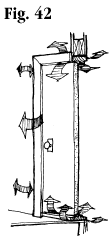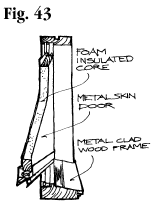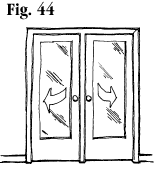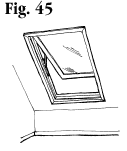|
Government Consumer's
Guide
Section 9 -
Doors, Patio Doors and Skylights
9.1 Doors
9.2 Patio Doors
9.3 Skylights
9.1 Doors
Doors have less impact than windows on the energy consumption of a home – unless they are patio or garden doors – simply because there are fewer of them. They come in a variety of materials, some of which reduce heat flow better than others. Depending on style and insulation material, for example, metal-clad doors are more efficient than solid wooden doors. No matter what the material, ill-fitting doors lose even more energy and can make the home drafty and uncomfortable.
Heat may be lost through the door and frame, between the door, frame, and sill, through glass in patio doors or doors with windows, and between the door frame and rough frame opening (Fig. 42). Heat loss through doors can be reduced through careful choice of the door, its location, and proper installation and maintenance. You can reduce heat loss simply by placing a door out of the path of prevailing winds, by locating it on the leeward side of a house, or by providing windbreaks. Another option is the use of an air-lock vestibule which traps the air between the exterior door and the interior of the house.

Properly designed and installed storm doors will provide some degree of increased efficiency, as well as protection from the weather. And, with screen inserts, they’ll provide summer ventilation. In southern and western exposures, care should be taken to avoid heat buildup between the doors which may cause the main door’s finish to blister. In extreme cases, the main door may actually warp due to this heat buildup.
Missing or worn weatherstripping, improperly located strike plates, frames which no longer fit the door correctly, or warped doors that no longer contact the stops are the main contributors to air leakage. These problems can all be corrected by a carpenter or competent do-it-yourselfer.
A badly deteriorated door should be replaced with a new one with energy-efficient insulation. Select good quality units and install them properly.
New insulated doors are usually made of foam and wood covered with metal (Fig. 43). Door frames are normally wood, clad with metal or vinyl. Doors that are mainly glass and are used as windows (for the view, daylight, etc.) should be compared for energy performance by their ER number. Glass inserts and side lights should have at least double-glazing with at least 12 mm (half inch) of air space between glazings and be compared on the basis of the U-value (or R-value) calculated for the complete door system.

Using the existing casing, the door and frame can be replaced with a factory-made, core-insulated, pre-hung unit. Installation takes less time than site-assembled systems, air seals are tighter and more durable, and these systems come with a thermally broken, adjustable sill assembly to reduce heat loss even further. A variety of materials may be used for the door face and framing, insulation, and weatherstripping.
In summary, when selecting doors for energy efficiency, look for:
- cores of materials that maintain high insulating values;
- wood, vinyl, or thermally broken metal frames;
- weatherstripping fabricated from high-performance, durable materials;
- low air leakage rates (for pre-hung door systems);
- maintenance-free framing materials; and
- a high Energy Rating (ER) or a minimum of double glazing with a 12 mm (half inch) or greater air space.
For details on specific doors, check with the manufacturer.
Back
to the Top
9.2 Patio Doors
Sliding glass patio doors are popular in Canada and can be energy-efficient if selected on the same basis as for windows. Sliding glass doors are covered by the CSA-A440.2 Energy Rating (ER) system and the CGSB 82.1 Standard.
With an existing patio door of good quality and in reasonable condition, air leakage may be reduced by replacing the door’s gaskets, weatherstripping and hardware. Doors not used in winter can be sealed shut with a removable sealant, or covered on the interior with heat-shrink plastic – kits are available to fit most doors.
A door in poor condition should probably be replaced. New sliders perform better than older models. However, hinged French doors with a centre post to close against (Fig. 44) will be more airtight, although they would still not be suitable in a more severe northern climate.

The same basic guidelines on glazing and frame materials apply for doors as for windows.
Back
to the Top
9.3 Skylights
Skylights can bring added light to a home and make it more attractive. However, if not designed or installed properly, they can lose far more heat than a standard roof and window, and can present special problems including water leakage, condensation, and summer overheating. Also, because of their different solar heat gain characteristics, the Energy Rating (ER) system does not apply to them although they are included in the CSA-A440.2 standard. Normally, a skylight’s thermal performance is indicated by its “U” value.
Skylights should be as resistant to heat loss as possible. This means that high, poorly insulated curbs should be avoided. The glazing should be as energy-efficient as possible. Low-E, gas-filled, insulated glazing units are a good choice. You may also want to consider light-reflective glass to reduce overheating, although this may also reduce the amount
of daylight.
An exterior awning, reflective film, or even whitewash can be applied in summer to reduce overheating problems. An extra layer of glazing on the inside of a skylight may also reduce condensation and heat loss.
If a skylight is badly deteriorated but necessary for daylighting, a replacement unit should be purchased. It should have the same features as high-performance windows, including a tightly sealing closure mechanism. On steep roofs, an operable roof window can provide many of the features of a good quality vertical window, including the ability to ventilate (Fig. 45). Roof windows can also be equipped with blinds to reduce unwanted summer sun.

Go to
Section 10: Deciding What You Need
Back to the Top
Home
Contact Us Search
Why Thermotech Consumer's
Guide Products
Links Stephen's
Column Copyright
© 2010 by Thermotech Fiberglass Fenestration Ltd.
Telephone:
1-888-930-9445 Facsimile:
613-839-9066 Website
design and layout by 2Design Web
|

